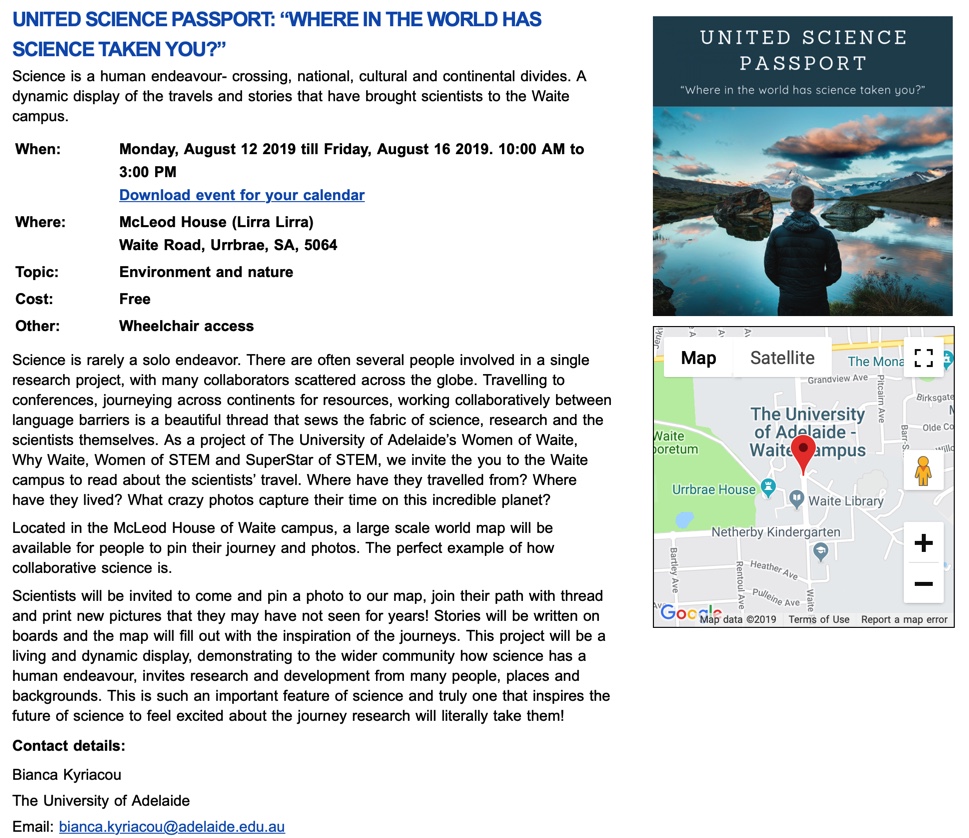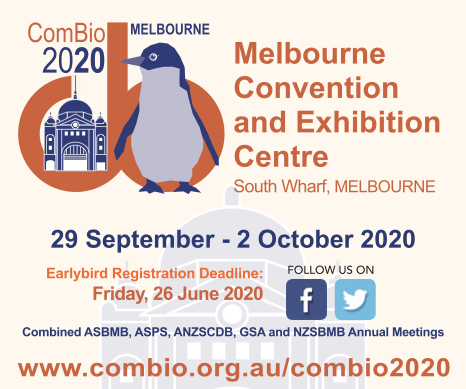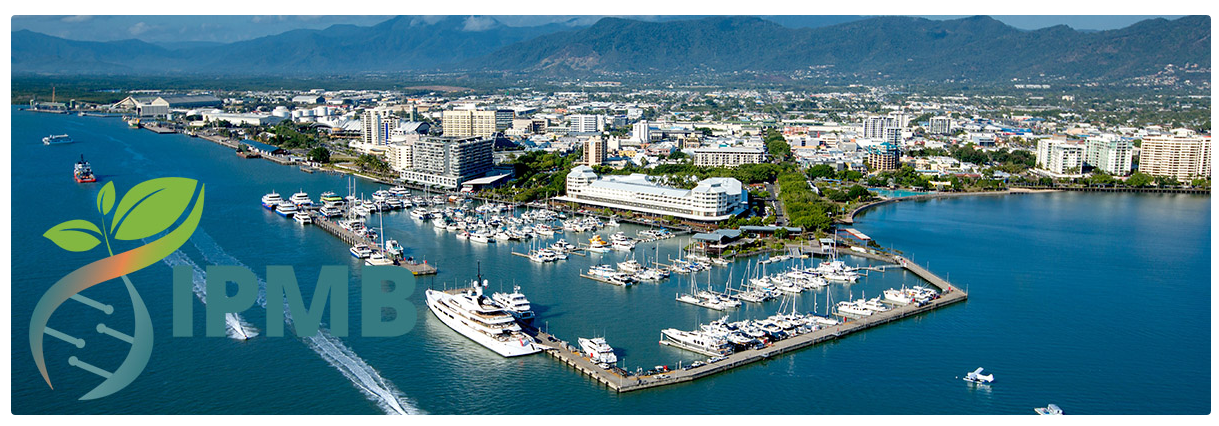- About
- Members
- Join
- Member log in
- Membership Renewal
- Member directory
- Life Members
- ASPS Life Member Professor Graham Farquhar
- ASPS Life Member Associate Professor Hendrik (Hank) Greenway
- ASPS Life Member Dr Marshall (Hal) D Hatch
- ASPS Life Member Dr Paul E Kriedmann
- ASPS Life Member Dr Mervyn Ludlow
- ASPS Life Member Emeritus Professor Rana Munns
- ASPS Life Member Conjoint Professor Christina E Offler
- ASPS Life Member Professor (Charles) Barry Osmond
- ASPS Life Member Emeritus Professor John W Patrick
- ASPS Life Member Dr Joe Wiskich
- Corresponding Members
- Elected Fellows
- Events
- Awards & Funding
- Employment
- Publications
- Research
- Teaching
- Menu
Phytogen – September 2019
10 September 2019
Welcome to Phytogen for September 2019. It is getting closer to our annual meeting. A draft timetable can be viewed on the ASPS2019 website. Abstracts for posters (only) are still open until 30th September. Registration is still open until then too. You can register and submit your poster abstracts by clicking on this link. We look forward to seeing you in November. It will be a busy month for science as Science meets Parliament will also be occurring.
Science meets Parliament is designed to bring together decision makers and Australia’s leading STEM professionals, to promote the role of science, technology, engineering and mathematics – and the valuable part these sectors can play in politics.
This will be the 20th year and ASPS will be represented by Tracey Cuin and Ricky Milne. Tracey works at the University of Tasmania. She is researching action potential signals through plants. Fast responses to an external threat depend on the rapid transmission of signals. Ricky works at CSIRO Agriculture and Food, Canberra. He is researching resistance to fungal pathogens, and exploiting the transferability of this resistance to other economically important crops. Fungal diseases such as rust pose a constant threat to global grain production.
Each year more than 200 scientists, technologists and STEM professionals take part in this unique event over two very full days. On Day One delegates hear from leaders in policy; media; science and technology; and advocacy. They share their rich insights through panel discussions, presentations and workshops. Day One then concludes with a Gala Dinner which traditionally sees the Prime Minister and Opposition Leader present their position and plans for science, technology and innovation in Australia.
On Day Two, delegates meet face-to-face with Parliamentarians across the political spectrum. It’s a chance for scientists and technologists to share their enthusiasm for science and information about their work and discipline. This is a rare opportunity to speak directly to politicians and is the highlight for most who attend. Delegates will also have the chance to be part of the live audience for the National Press Club Address and to attend a session of Parliamentary Question Time. Additionally, delegates get ample opportunities to meet other men and women working in STEM – from early career researchers through to senior decision-makers. Below are reports from Janet Wheeler, La Trobe University and Mike Haydon, Melbourne University who attended in 2018.
Janet: In Feb 2018 I represented ASPS at Science meets Parlianment. It was a whirlwind 2 days with plenty of networking, seminars, workshops, meetings and photo opportunities.
The first day was spent at the National Gallery where we heard from Dr Cathy Foley, CSIRO Chief Scientist who highlighted the responsibility we have to ensure our elected leaders have the opportunity to access our expertise. Science and technology effect the available solutions. Dr Foley also shared advice on how to hone your pitch and shape the discussions we would be having the following day with members of parliament.
The next morning we made our way through security at Parliament House and saw “Chuck the shrimp” embeded in the foyer floor. 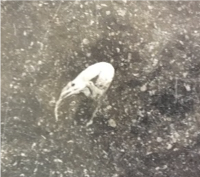 I met with Graham Perrett Federal Member for Moreton (Qld) and highlighted the significant contribution plants make to the Australian ecomomy and contibution plant science makes to current and future challenges.
I met with Graham Perrett Federal Member for Moreton (Qld) and highlighted the significant contribution plants make to the Australian ecomomy and contibution plant science makes to current and future challenges.
Another highlight for me was seeing Question Time in person. It happened to be an exciting day as Barnaby Joyce was a day or so away from steping down as Deputy Prime Minister. So theatrical.
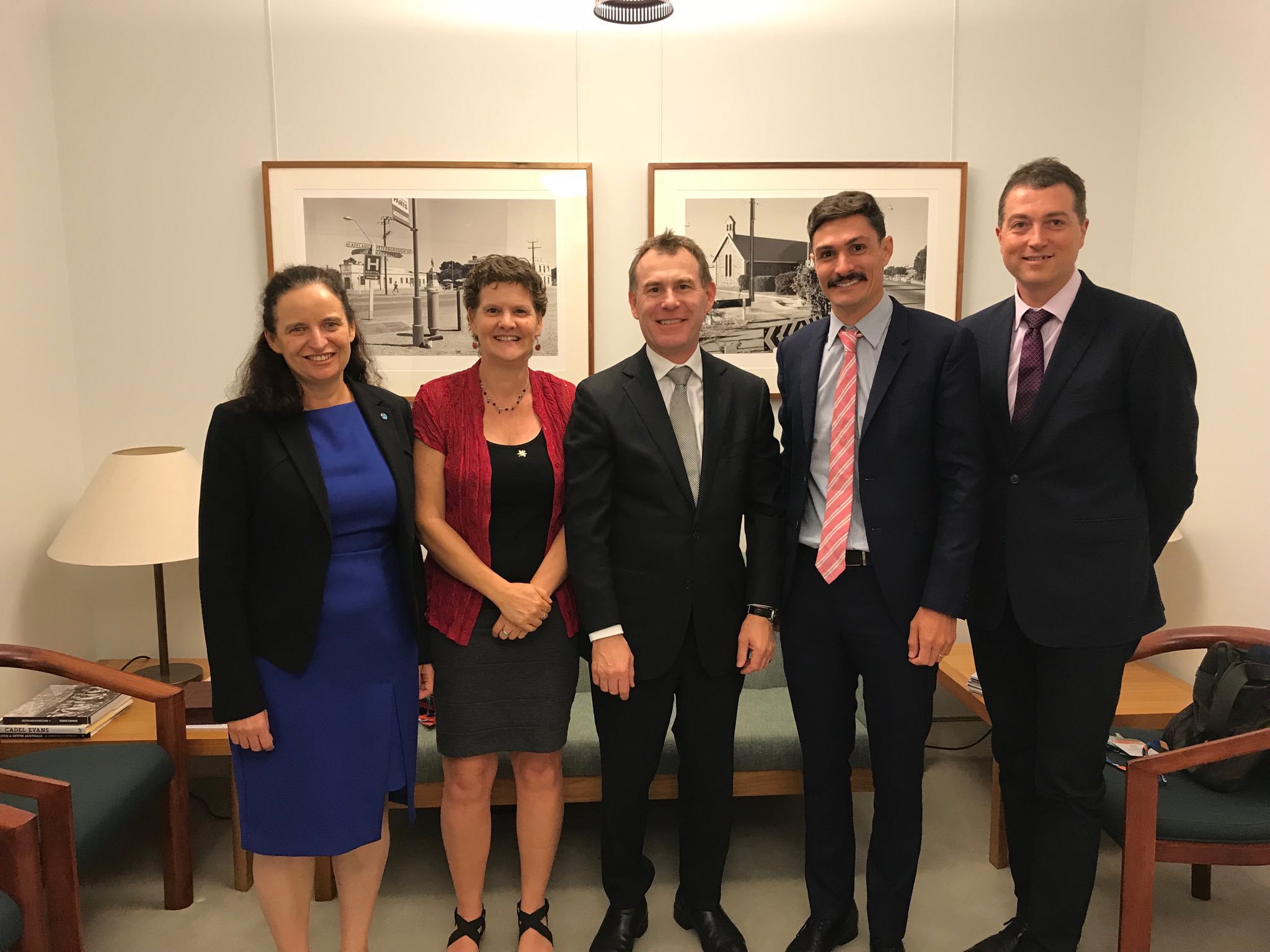
Mike Haydon (second from right) with Nick Champion (middle) and Rachel Burton (second from left).
Mike: I had the pleasure of representing the ASPS as a delegate at Science meets Parliament in February 2018, a major annual event organised by Science and Technology Australia. I enjoy the circus that is Australian politics and so it was quite a thrill to get some insight into the ‘Canberra bubble’. The first day was at the National Gallery of Australia and included talks, networking and panel discussions on science policy and engagement, involving our Chief Scientist, prominent science communicators and experienced lobbyists. In the evening, we attended the Gala Dinner in the Great Hall in Parliament House, where we mixed with MPs and were addressed by the then Opposition Leader, Bill Shorten, and the Minister for Jobs and Innovation, Michaelia Cash. This was before the infamous whiteboard incident and subsequent controversies.
On day two we attended Parliament House. There was a program of presentations from parliamentary science advocates including Kim Carr, Adam Bandt, Karen Andrews and Richard Marles, each making promises about supporting science. The major feature of SmP is the opportunity to meet with Parliamentarians in small groups. Together with Rachel Burton, I spent a relaxed 30 minutes with Nick Champion, the Assistant Shadow Minister for Science. We enjoyed lunch at the National Press Club, during which we were passionately addressed by Emma Johnson, the Presidentof STA, about the importance of supporting Australian science. In the afternoon, we were entertained by the interrogation of Barnaby Joyce during Question Time over his living arrangements.
I greatly valued the opportunity to attend SmP on behalf of ASPS. It provided a new perspective on how to contribute to science policy, presented novel networking opportunities and was a great experience to be inside The House.
To finish, have a look at #tsbakeoff and @TSCommissioner for Australia’s threatened species of plants and animals.
Barry Osmond Symposium and ASPS2019 draft timetable
01 September 2019
Hello ASPS members,
We’d like to draw you attention to the Symposium celebrating Barry Osmond: Reflections in a Flash which will be held Sept 12th and 13th at ANU. Registration and further information can be found on the ASPS events page HERE.
The ASPS2019 draft timetable is now available HERE or on the ASPS2019 website HERE.
August Phytogen and GPC e-bulletin
19 August 2019
Hello ASPS members,
The August edition of Phytogen has been published and can be accessed here.
The GPC August e-bulletin can be viewed here.
New employment opportunities have been posted on the ASPS job board and can be viewed here.
Phytogen – August 2019 Where in the World has Science taken you?
14 August 2019
It is National Science Week this week. 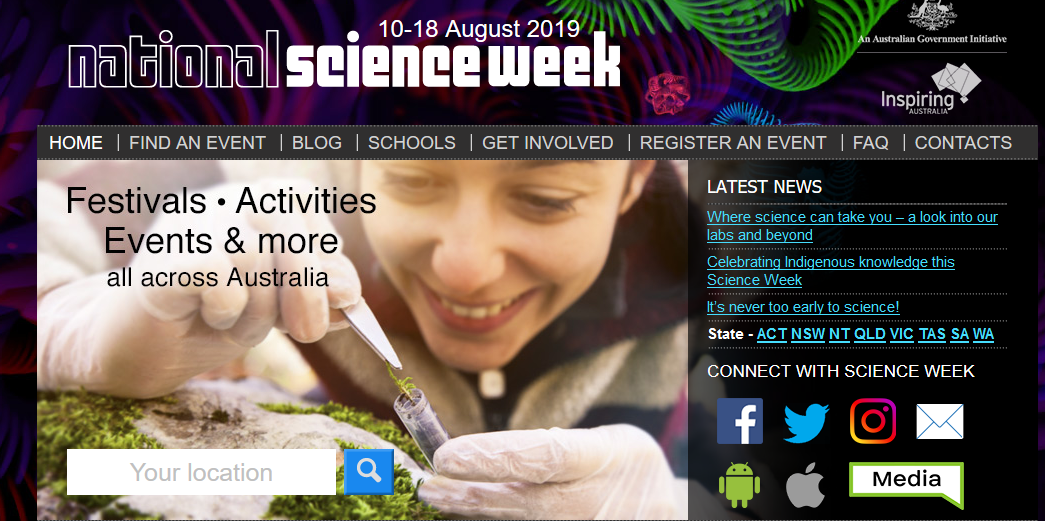 Taking a look at the events got me thinking about how amazing our peer networks and our travels have been. In particular, I draw your attention to an event occurring at Adelaide University
Taking a look at the events got me thinking about how amazing our peer networks and our travels have been. In particular, I draw your attention to an event occurring at Adelaide University
Even though you all won’t be able to make it to Adelaide this week, the theme of global peer networks is evident in this report by John Evans reflecting on this years Translational Photosynthesis Conference.
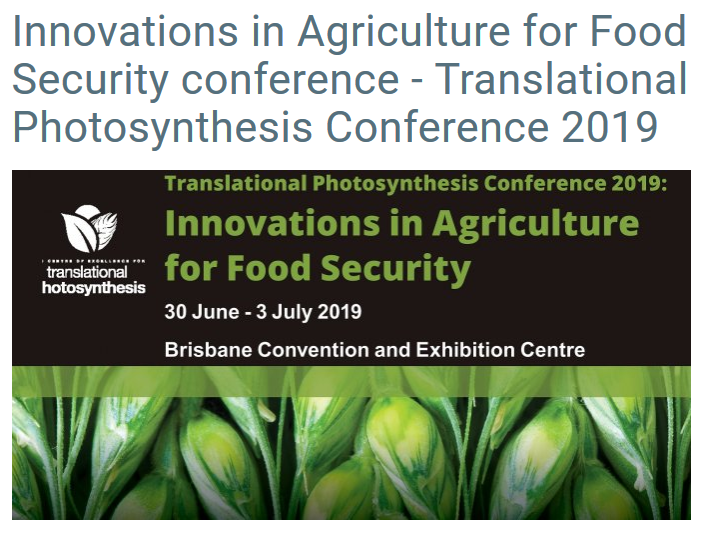
Report on the conference Innovations in Agriculture for Food Security
by John Evans
ASPS was one of the sponsors of this conference that was held at the Brisbane Convention and Exhibition Centre (30 June – 3 July). Over 100 people attended, including Professor Susanne Schmidt and Sana Khan from UQ who represented ASPS. To promote ASPS, a beautiful banner was designed and displayed.
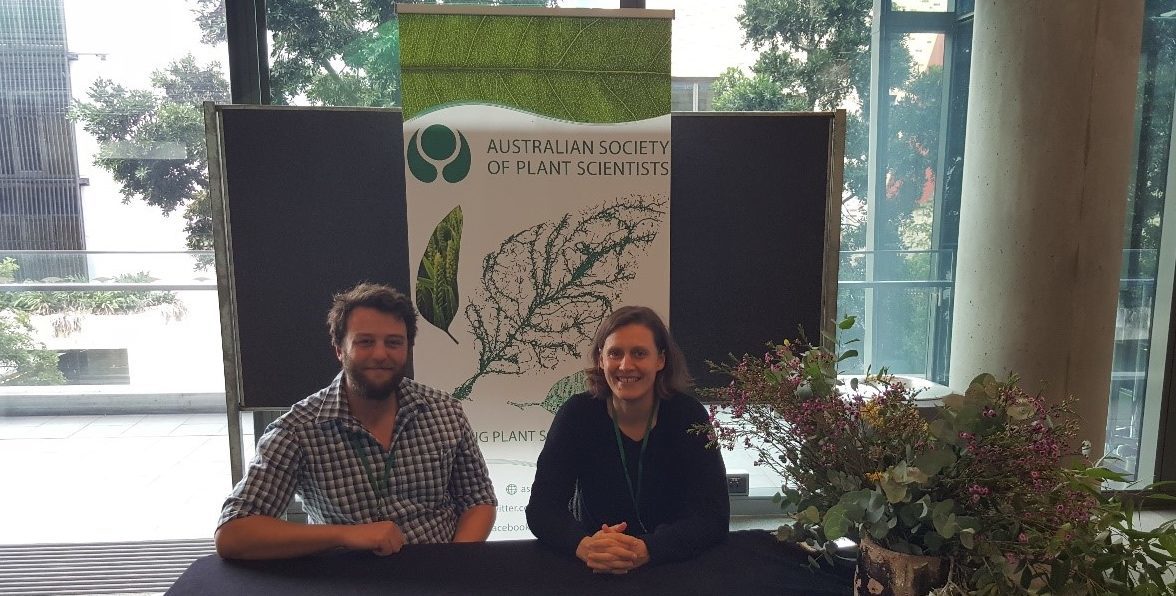
Tam Salter and Caitlin Byrt sat in front of the ASPS banner they designed.
Attendees came from the UK, Germany, Canada, USA, China, the Philippines, Czech Republic, Australia and NZ. One aim of the meeting was to raise awareness of the broader context within which researchers work. Establishing contacts and a network of people can be of great benefit to science and careers, so the meeting began on the Sunday evening with a forum for the next generation, organised by Alex Wu. Plenty of time was allocated to the morning and afternoon poster sessions. Preceding these sessions, poster presenters introduced themselves in flash talks to encourage people to come and discuss their work. It was clear from the animated groups, that these opportunities were well used. The ECR (usually early career researcher) acronym was redefined by Barry Osmond to include end of career, but his enthusiasm for espousing the possibilities of LIFT (laser induced fluorescence transient) method, clearly showed he is embarking on yet another research phase. By contrast, Graham Farquhar regaled us over the conference dinner with how many times during his early career his next step was only made possible by personal recommendations rather than from an excellent academic record. Metrics and regulation are the current challenges that need to be mastered by us all if we want to achieve career and food security.
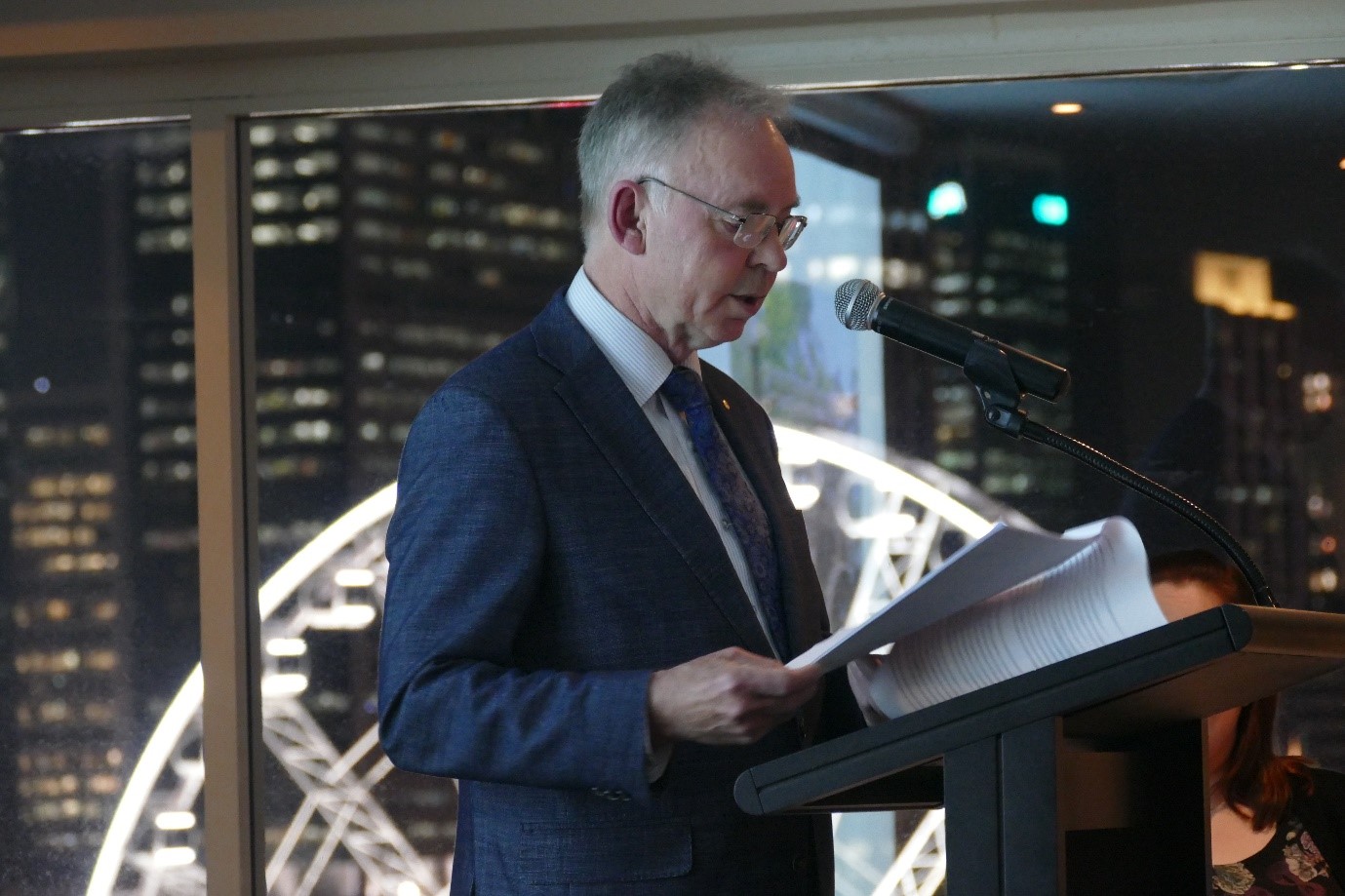
Graham Farquhar recounting his early career as the ferris wheel spun behind him during the conference dinner (Photo by Natalia Bateman)
Raj Bhula, from OGTR (Office of the Gene Technology Regulator; Australian Government), explained the current state of Australian regulation for genetic modification of organisms. It is important that ASPS members take the opportunity to submit responses to enquiries over future changes to regulation so that the voice of scientific practitioners can be heard and counter activist groups that are opposed to GMOs. This is particularly pertinent for the rapidly emerging capability offered by CRISPR cas9.
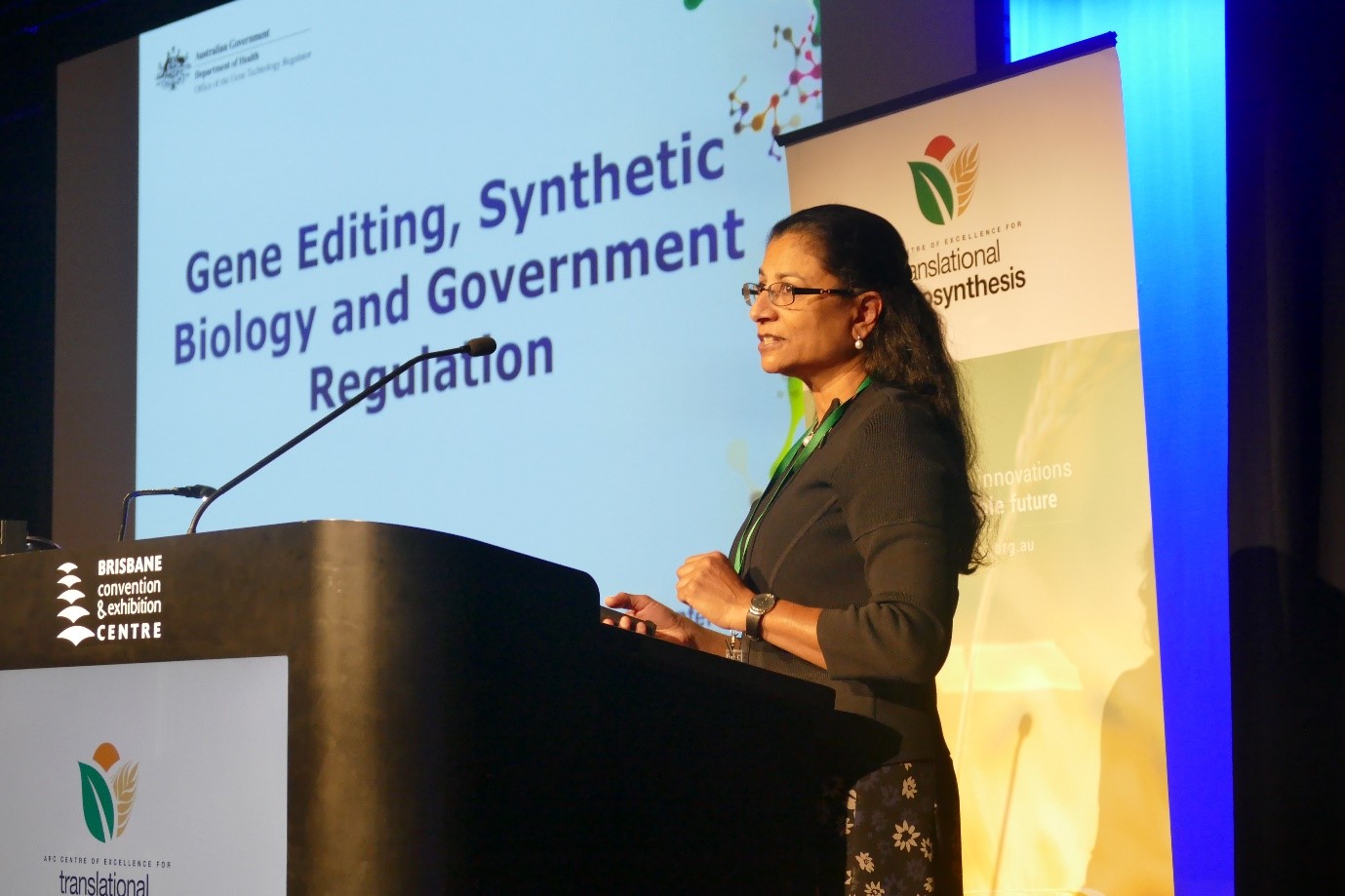
Dr Raj Bhula, from Australia’s Office of Gene technology regulator (OGTR), delivering her keynote address (Photo by Natalia Bateman)
One final highlight was the keynote talk from Mark Stitt who reminded us of the problems we cause plants when growing them in square wave controlled environments. Turning the light on and off abruptly rather than gentle light transitions through natural dawn and dusk plays havoc with gene expression and presumably disrupts plant physiology.
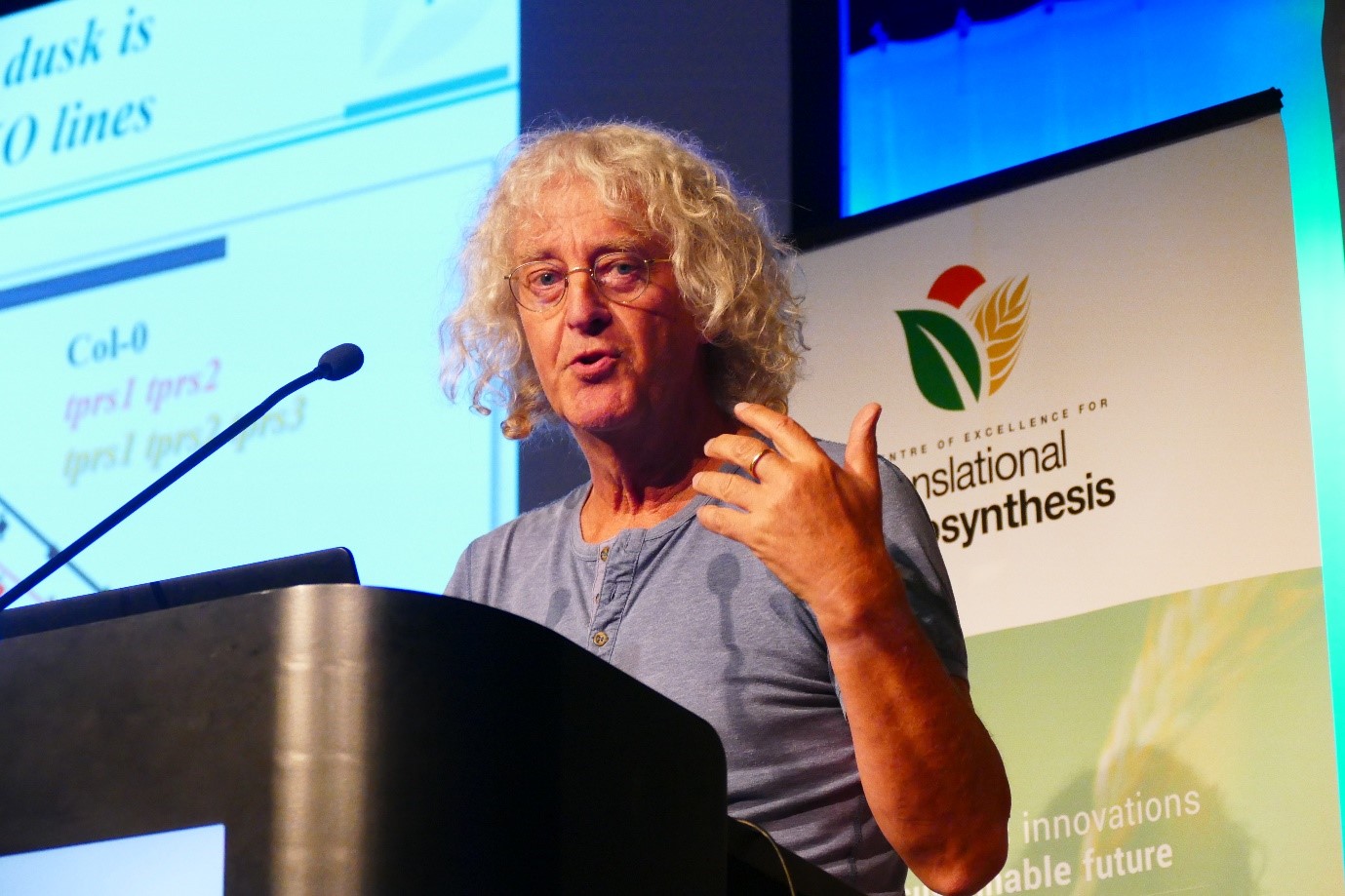
Mark Stitt delivering his keynote address (Photo by Natalia Bateman)
Lastly, here is a report from one of our RN Robertson Travel Fellowship awardees. Carolyn Vlasveld from Monash University visited the University of Tasmania in May-Jun 2019.
RN Robertson Travelling Fellowship Report
by Carolyn Vlasveld
My PhD involves understanding differences between the leaves of juvenile and adult eucalypts. Working on this has led me towards studying juvenile-adult differences from the context of leaf hydraulic function. Consequently, the more discussion I had with my supervisors, the more it became apparent that I should investigate differences in leaf physiological traits. But my knowledge at the time entailed more about the ecology of morphological traits – I had little understanding of leaf physiology and measuring physiological traits.
This led me to visit Tim Brodribb’s laboratory at the University of Tasmania (UTAS) with the help of the RN Robertson Travelling Fellowship. A major focus of their work is the evolution of leaf physiological traits fundamental to hydraulic function. They had recently found differences in xylem vulnerability between the juvenile and adult leaves of Eucalyptus globulus (Lucani et al. 2019), using their novel optical vulnerability (OV) method. They suggested that I learn this method because it is often simpler than previous methods for measuring xylem vulnerability.
My visit focused on learning the OV method, among other techniques important to my thesis, such as preparing stained leaf samples for viewing anatomical structures. I measured the leaf xylem vulnerability of Eucalyptus globulus trees growing at the UTAS campus. The OV method involves measuring water potential and cumulative embolisms over time by using an optical camera. The camera detects embolism events by taking a time-lapse series of images of a dehydrating leaf. Light is transmitted through the leaf blade for each photograph. After xylem conduits embolise, they transmit less light through the leaf. Consequently, the occurrence of an embolism is detected by the light difference between two sequential images in the time-lapse. These embolism occurrences are later isolated and translated from the images to quantify cumulative embolisms as leaf water potential decreases over time.
A 3D-printed clamp containing the camera is secured over a dehydrating leaf, which encloses a section of the blade to prevent the entry of outside light. The camera connects to a raspberry pi computer, which programs the process of taking sequential photographs. Meanwhile I also learnt to use a Scholander pressure bomb and psychrometer to measure water potential.
This method will be used in my thesis to compare xylem vulnerability in other species occurring in different environments, and I wish to stay in contact with those at UTAS through this process.
I loved staying in Hobart and winter was a perfect time to visit – I caught the Pint of Science at Shambles Brewery, the view of snowy Mount Wellington from the city, and the UTAS School of Biological Sciences’ famous “Crib Night” where everyone dresses up to have a cribbage tournament.
Thank you very much to the Australian Society of Plant Scientists, the RN Robertson Fund, and the University of Western Australia for helping me take this trip. Thank you also to Tim Brodribb and others in his laboratory for making me feel welcome and sharing their skills and knowledge. This visit enriched my experience as a PhD student in addition to learning new techniques required for my thesis and increasing my understanding of leaf hydraulic function.
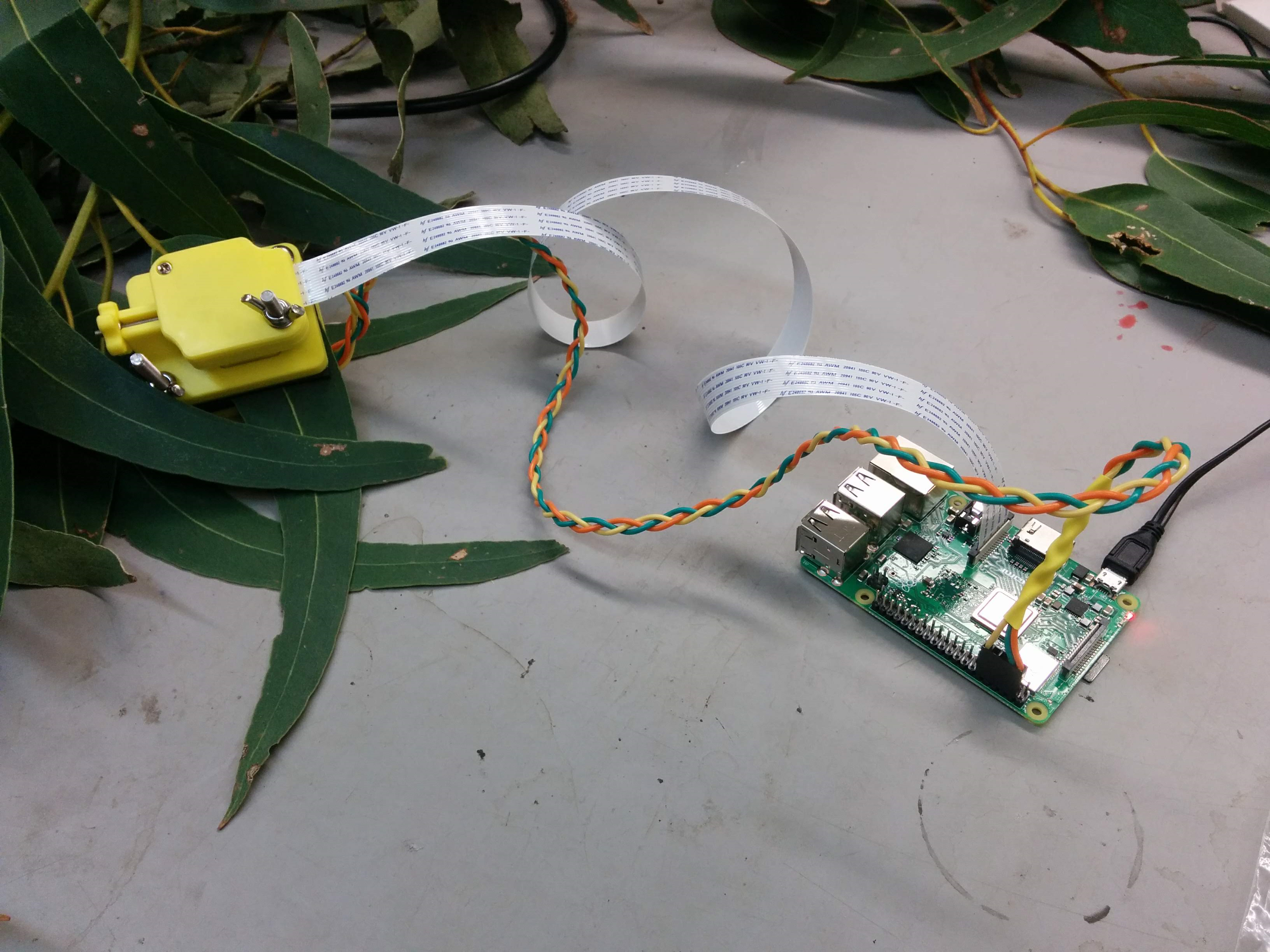
3D-printed leaf clamp containing a time-lapse camera (left) which connects to a raspberry pi computer (right)
References
Lucani CJ Brodribb TJ, Jordan GJ & Mitchell PJ (2019) Juvenile and adult leaves of heteroblastic Eucalyptus globulus vary in xylem vulnerability. Trees 1-12.
I hope you will be able to finish off the week attending a science event near you or catching up with your peers and their travels at an upcoming meeting, many are listed on our website (upcoming events/add an event page under the events tab) and you can add events…….. Next month will be reports from Science Meets Parliament.
| ASPS 2019 to be held 26-29th November 2019 is an event not to be missed! It will bring together plant scientists from across Australia and will be held at AgriBio, La Trobe University, Melbourne. |
| In 2020, |
| In 2021,
the 13th International Congress on Plant Molecular Biology will be in Cairns, Australia |
ASPS2019 early bird registration and oral abstract submission closing July 31st and employment opportunities
29 July 2019
Hello ASPS members,
Your last reminder the deadline for ASPS2019 early bird registration and abstract submission is in three days (July 31st).
You can register for ASPS2019 here.
You can submit an abstract here.
There are also many employment opportunities posted through the ASPS here.
July Phytogen, GPC e-bulletin and ASPS2019 registration and oral abstract submission closing July 31st.
22 July 2019
Hello ASPS members,
The July edition of Phytogen has been published. You can access the latest edition here.
The July GPC e-bulletin can be accessed here.
The deadline for ASPS2019 early bird registration and abstract submission is in nine days (July 31st).
You can register for ASPS2019 here.
You can submit an abstract here.
Phytogen – July 2019 Blast-off!
21 July 2019
Now we are past the middle of the year and to think, 50 years ago today astronauts were walking on the moon. I hope over the next few weeks you will marvel at the stars and this may inspire you in your current pursuits.

In our July issue, we recognise two Award Recipients, Dr Caitlin Byrt and Associate Professor Sigfredo Fuentes. Caitlin Byrt is a bright emerging researcher awarded the Peter Goldacre Award in 2018. I always remember from seeing her talk the multitude of collaborators she acknowledged. It demonstrated a vibrant global community supporting her to reach for the stars and tackle the grand challenge of maximising plant yields.
In Melbourne this year, we can look forward to hearing from the 2019 award recipient, Simon Williams from the Australian National University.
Peter Goldacre was a foundation member of ASPP, and an enthusiastic supporter of the Society from its inception. With a Science Degree from the University of Sydney, majoring in chemistry and biochemistry, he took up a research position at what was then the CSIR Division of Plant Industry in Canberra in 1947. Peter was an enthusiastic researcher who was held in great respect by his peers. His tragic death in 1960 from stomach cancer at age 34 shocked and saddened all his friends and colleagues. The Goldacre Medal was subsequently established as a lasting tribute to his contributions in plant physiology, and as an encouragement to young researchers. Functional Plant Biology now sponsors the Goldacre Award. The Award is made on the merit of original research in one area, the findings of which have been published, or accepted for publication, in the three years preceding the year of the Award. The work should have been done within 10 years of the candidate submitting their PhD.
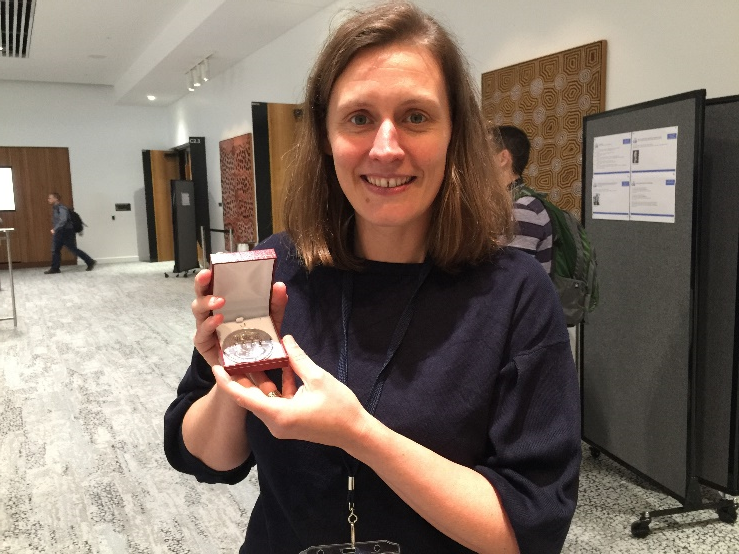 The recipient of the 2018 Goldacre Award, Dr Caitlin Byrt (University of Adelaide, now Australian National University) for her work on studying membrane transporters towards enhancing crop yields.
The recipient of the 2018 Goldacre Award, Dr Caitlin Byrt (University of Adelaide, now Australian National University) for her work on studying membrane transporters towards enhancing crop yields.
ComBio 2018 Peter Goldacre Lecture Abstract
CELL MEMBRANE WATER CHANNELS WITH BUILT IN ION CHANNELS
Byrt C.S.1, 2, Qiu J.1, 2, McGaughey S.1, 2, Groszmann M. 3, 4, Bose J.1, 2 and Tyerman S.D.1, 2
1The University of Adelaide. 2ARC Centre of Excellence in Plant Energy Biology. 3 Australian National University. 4 ARC Centre of Excellence for Translational Photosynthesis
Cell function is dependent on maintenance of water and ionic homeostasis. Aquaporins are regulated by cells to achieve water homeostasis, but in addition they may also be required for ion homeostasis. Cell water permeability is determined by the water conductance and density of aquaporins present in the plasma membrane. Plants express in the order of 30 to 70 different types of aquaporins, depending on the plant species, and these include a group called PIPs that are particularly abundant in plasma membranes. PIPs generally form tetramers with each monomer capable of allowing the passage of water. There are subsets of PIP tetramers that allow passage of other solutes, and we have identified PIPs that can change between functioning as water channels and non-selective cation channels (NSCCs) when expressed in heterologous systems. In plants there are likely to be multiple types of NSCCs and previous studies have revealed that NSCCs, for which the molecular candidates are so far unidentified, can provide a pathway for nutrient transport, and also for sodium transport under salinity stress. PIPs functioning as ion channels can allow passage of sodium and potassium, and they share similar properties with previously reported NSCCs. For example, NSCC and PIP ionic conductance are sensitive to calcium, pH and cyclic nucleotides. We are testing whether PIPs can account for any of the previously observed NSCC functions in plants by studying ion transport traits in mutant and transgenic lines of Arabidopsis where the PIPs of interest are either knocked out, overexpressed or mutated to change their ion channel function. Testing whether PIPs are implicated in maintaining water and ionic homeostasis in plants is an important step towards resolving the roles of PIPs in plant tolerance to dry, saline and nutrient deficient environments.
https://onlinelibrary.wiley.com/doi/full/10.1111/pce.12832
|
The aquaporin AtPIP2;1 is an abundant plasma membrane intrinsic protein in Arabidopsis thaliana that is implicated in stomatal closure, and is highly expressed in plasma membranes of root epidermal cells. When expressed in Xenopus laevis oocytes, AtPIP2;1 increased water permeability and induced a non‐selective cation conductance mainly associated with Na +.
onlinelibrary.wiley.com
|
For: Byrt, C.S., Zhao, M., Kourghi, M., Bose, J., Henderson, S.W., Qiu, J., Gilliham, M., Schultz, C., Schwarz, M., Ramesh, S.A. and Yool, A., 2017. Non‐selective cation channel activity of aquaporin AtPIP2; 1 regulated by Ca2+ and pH. Plant, cell & environment, 40(6), pp.802-815.
Next, Associate Professor Sigfredo Fuentes is awarded the Plant Science Teaching Prize for Plant Physiology. We will look forward to hearing from him at ASPS2019 at La Trobe University from 26th-29th November.
Sigfredo Fuentes is an Associate Professor in Digital Agriculture, Food and Wine Sciences at the University of Melbourne. His previous research employment include the University of Adelaide, Univ. of Technology, Sydney; Univ. of Western Sydney (PhD) and Univ. of Talca, Chile. His repertoire ranges from climate change impacts on agriculture, development of new computational tools for plant physiology, food and wine science, new and emerging sensor technology, proximal, short- and long-range remote sensing using robots and UAVs, and the application of machine learning and artificial intelligence in these fields.
For more information visit: www.vineyardofthefuture.wordpress.com
 In the present age, students and majority of young people are heavily engaged and reliant on smart devices (smart phones and tablet PCs) as part of daily routines. It is therefore wise to take advantage of this avenue to deliver learning tools right into the hands of students. Advances in digital technologies in the form of portable smart devices and app-based sensor technologies, such as infrared thermal imaging and near infrared spectroscopy devices, have made the development and application of novel tools for teaching and learning purposes in plant physiology readily accessible. The adeptness of students to handheld technology enabled these tools to be easily implemented, with high reception, engagement and interest.
In the present age, students and majority of young people are heavily engaged and reliant on smart devices (smart phones and tablet PCs) as part of daily routines. It is therefore wise to take advantage of this avenue to deliver learning tools right into the hands of students. Advances in digital technologies in the form of portable smart devices and app-based sensor technologies, such as infrared thermal imaging and near infrared spectroscopy devices, have made the development and application of novel tools for teaching and learning purposes in plant physiology readily accessible. The adeptness of students to handheld technology enabled these tools to be easily implemented, with high reception, engagement and interest.
The recipient of the 2019 Plant Science Teaching Prize for Plant Physiology, Associate Professor Sigfredo Fuentes, University of Melbourne for application of new and emerging technologies for digital teaching and learning in plant physiology.
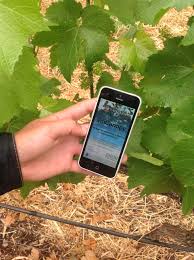 UAVs and Apps
UAVs and Apps
The development of teaching and learning tools based on new and emerging technologies is a critical step to increase engagement of students in complicated physiological processes of plants, such as transpiration rate, stomatal conductance, nutrient levels and photosynthesis rate, among others, that can be assessed in real time. These tools have the potential to be delivered right into the students’ smart phones, providing individualised access and hands-on learning experience. It has been a common practice for students to show these apps to peers and family members, which have increased the engagements of their circles either through direct contact or posting results into social media.
Since 2008, Sigfredo has been actively creating and writing computer codes, programs and computer Applications (Apps) for Plant Science teaching and research. Some of these tools have been adopted commercially and by other national and international tertiary teaching & research institutions in South America (Chile and Argentina), USA, Europe (Spain, France and Italy), China and South Africa. Furthermore, most of the tools have been published in peer reviewed journals and have been used by a number of undergraduate / postgraduate students for their Bachelors, Master and PhD degrees not only in Australia but also around the world. These tools have also helpedtogenerate new ideas on the implementation of computer and sensor applications using the Internet of Things (IoT) in Plant Science and Agriculture and have been used to support lectures and practical from Plant Science, Food Science, Sensory Science, Animal Science, Engineering, Viticulture and Oenology subjects at national and international universities. Specific codes for multivariate statistical analysis have been also developed with respective manuals (teaching publications). These tools have facilitated student learning experience and research performance, resulting in high Student Experience Survey scores (Average of 4.1 from 5 for all subjects).
- Wetting Pattern Analyser (WPA©): 2D and 3D visualization of soil moisture and salinity/nutrient patterns from soil moisture/salinity sensors. Adopted commercially by Sentek Pty. Ltd. (www.sentek.com.au).
- BerryAlive: Computer code written in Matlab® to analyse fluorescence microscopy images of berries to estimate berry cell death and shrivel.
- VitiCanopy: A computer application (App) for tablet PCs and smartphones to assess canopy architecture and leaf area index for horticultural crops using cover photography and computer vision algorithms. https://www.plantransig.com/techniques/viticanopy/
- Spatial Vigour / Spectral Analyser:Analysis of spatial canopy vigour and multispectral analysis using computer vision algorithms at the plant-by-plant scale from UAV or satellite imagery,
- IR-CanopyAnalyser: High throughput automated analysis of infrared thermal images from canopies to obtain canopy conductance indices and crop water stress indices.
- PCA-Cov: Principal component and covariance analysis codes for graphical and numerical outputs written in Matlab® with associated manuals. These tools have helped to improve Student Experience Survey scores from courses associated with this type of analysis.
- Inspector-PAW: Computer App developed for Android OS to automatically acquire accelerometer and GPS data from a smartphone device located in backpacks of trained dogs to record data from identified stimuli such as weeds, pest and diseases detection in orchards. Data can be later on mapped using GIS and modelled using machine learning algorithms. Publication under preparation.
- AppleZize App: Computer App developed to identify diameter of apple fruits and extraction of fruit temperature from digital and infrared images in the field. Information acquired is then plugged in developed algorithms using machine learning techniques to assess final fruit size at harvest and sunburn risk. Publications in preparation.
- LeafDetector: Matlab code developed to extract morpho-colorimetric data from scanned/photographed leaves. Data automatically extracted includes more than 15 parameters, such as diameter, perimeter, fractal analysis of the edges, colour in the CieLAB and RGB codes. Machine learning algorithms can be developed to recognise cultivars automatically from leaf images. Applied already to grapevine cultivars and Chinese medicinal plants.
- Machine learning batch analysis:code developed to test machine learning algorithms using plant physiology data as inputs and targets such as: smoke contamination in leaves and berries; transpiration rate (day and night); plant water status, among others. This code tests around 60 ML algorithms, such as Artificial Neural Networks, Decision trees, Support vector machines, among others.
Some Relevant Publications and Tools Employed
- Xiaoyi Wang, Roberta De Bei, Sigfredo Fuentes, Cassandra Collins: Influence of Canopy Management Practices on Reproductive Performance of Semillon and Shiraz Grapevines in a Hot Climate. American Journal of Enology and Viticulture 04/2019; (Tools: 3).
- J. Tongson, S. Fuentes, M. Carrasco-Benavides, M. Mora: Canopy architecture assessment of cherry trees by cover photography based on variable light extinction coefficient modelled using artificial neural networks. Acta horticulturae 02/2019;, DOI:10.17660/ActaHortic.2019.1235.24. (Tools: 3).
- De Bei, S. Fuentes, M.G. Wirthensohn, D. Cozzolino, S.D. Tyerman: Feasibility study on the use of Near Infrared spectroscopy to measure water status of almond trees. Acta horticulturae 10/2018;, DOI:10.17660/ActaHortic.2018.1219.14. (Tools: 4).
- Xue Jinru, Sigfredo Fuentes, Carlos Poblete-Echeverría, Claudia Gonzalez Viejo, Eden Tongson, Baofeng Su (2019): Automated Chinese medicinal plants classification based on machine learning using leaf morpho-colorimetry, fractal dimension and visible / near infrared spectroscopy. International Journal of Agricultural and Biological Engineering (Accepted); (Tools: 9, 10).
- Xue Jinru, Yeman Fan, Baofeng Su, Sigfredo Fuentes(2018): Assessment of Canopy Vigor Information from Kiwifruit Plants Based on a Digital Surface Model from Unmanned Aerial Vehicle Imagery. International Journal of Agricultural and Biological Engineering;, DOI:10.25165/j.ijabe.20191201.4634. (Tools: 4).
- Zuniga M., Ortega-Farias S., Fuentes S., Riveros-Burgos C., Poblete-Echeverria C. 2018. Effects of three irrigation strategies on gas exchange relationships, plant water status, yield components and water productivity on grafted Carmenere grapevines. Frontiers in Agriculture. 9: 992. (Tools: 5, 6).
- Fuentes S., Hernández-Montes E., Escalona JM., Bota J. Gonzalez Viejo C., Poblete-Echeverría C., Tongson E., Medrano H. 2018. Automated grapevine cultivar classification and water stress assessment based on machine learning using leaf morpho-colorimetry, fractal dimension and near-infrared spectroscopy. Computers and Electronics in Agriculture. 151: 311-318. (Tools: 9, 10).
- Sajitha Biju, Sigfredo Fuentes, Dorin Gupta. The use of infrared thermal imaging as a non-destructive screening tool for identifying drought-tolerant lentil genotypes. Plant Physiology and Biochemistry. 127., DOI:10.1016/j.plaphy.2018.03.005. (Tools: 5, 6).
- Maria Romero, Yuchen Luo, Baofeng Su, Sigfredo Fuentes. Vineyard water status estimation using multispectral imagery from an UAV platform and machine learning algorithms for irrigation scheduling management. Computers and Electronics in Agriculture. 147., DOI:10.1016/j.compag.2018.02.013. (Tools: 4, 10).
- Suyoung Park, Dongryeol Ryu, Sigfredo Fuentes, Hoam Chung, Esther Hernández-Montes, Mark O’Connell: Adaptive Estimation of Crop Water Stress in Nectarine and Peach Orchards Using High-Resolution Imagery from an Unmanned Aerial Vehicle (UAV). Remote Sensing 08/2017; 9(828)., DOI:10.3390/rs9080828. (Tools: 4, 5).
- Baofeng, S., Jinru, X., Chunyu, X., Yulin, F., Yuyang, S., & Fuentes, S.(2016). Digital surface model applied to unmanned aerial vehicle based photogrammetry to assess potential biotic or abiotic effects on grapevine canopies. International Journal of Agricultural and Biological Engineering, 9(6), 119. (Tools: 4).
- Mora, M., Avila, F., Carrasco-Benavides, M., Maldonado, G., Olguín-Cáceres, J., & Fuentes, S.(2016). Automated computation of leaf area index from fruit trees using improved image processing algorithms applied to canopy cover digital photograpies. Computers and Electronics in Agriculture, 123, 195-202. (Tools: 3).
- De Bei, R., Fuentes, S., Gilliham, M., Tyerman, S., Edwards, E., Bianchini, N., . . . Collins, C. (2016). VitiCanopy: A free computer App to estimate canopy vigor and porosity for grapevine. Sensors, 16(4), 585. (Tools: 3).
- Carrasco-Benavides, M., Mora, M., Maldonado, G., Olguín-Cáceres, J., von Bennewitz, E., Ortega-Farías, S., John Gajardo and Fuentes, S.(2016). Assessment of an automated digital method to estimate leaf area index (LAI) in cherry trees. New Zealand Journal of Crop and Horticultural Science, 44(4), 247-261. (Tools: 3).
- Park, S., Nolan, A., Ryu, D., Fuentes, S., Hernandez, E., Chung, H., & O’Connell, M. (2015) Estimation of crop water stress in a nectarine orchard using high-resolution imagery from unmanned aerial vehicle (UAV). Paper presented at the MODSIM2015, 21st International Congress on Modelling and Simulation. (Tools: 5).
- Nolan, A., Park, S., Fuentes, S., Ryu, D., & Chung, H. (2015). Automated detection and segmentation of vine rows using high resolution UAS imagery in a commercial vineyard.Paper presented at the MODSIM2015, 21st International Congress on Modelling and Simulation. (Tools: 5).
- Poblete-Echeverría, C., Fuentes, S., Ortega-Farias, S., Gonzalez-Talice, J., & Yuri, J. A. (2015). Digital cover photography for estimating leaf area index (LAI) in apple trees using a variable light extinction coefficient. Sensors, 15(2), 2860-2872. (Tools 3).
- Fuentes, S., Poblete‐Echeverría, C., Ortega‐Farias, S., Tyerman, S., & De Bei, R. (2014). Automated estimation of leaf area index from grapevine canopies using cover photography, video and computational analysis methods. Australian Journal of Grape and Wine Research, 20(3), 465-473. (Tools: 3).
- Bonada, M., Sadras, V., Moran, M., & Fuentes, S.(2013). Elevated temperature and water stress accelerate mesocarp cell death and shrivelling, and decouple sensory traits in Shiraz berries. Irrigation Science, 31(6), 1317-1331. (Tools: 2).
- Fuentes, S., Mahadevan, M., Bonada, M., Skewes, M., & Cox, J. (2013). Night-time sap flow is parabolically linked to midday water potential for field-grown almond trees. Irrigation Science, 31(6), 1265-1276. (Tools: 2).
- Bonada, M., Sadras, V. O., & Fuentes, S. (2013). Effect of elevated temperature on the onset and rate of mesocarp cell death in berries of Shiraz and Chardonnay and its relationship with berry shrivel. Australian Journal of Grape and Wine Research, 19(1), 87-94. (Tools: 2).
- Conn, S. J., Hocking, B., Dayod, M., Xu, B., Athman, A., Henderson, S., . . . Fuentes, S.(2013). Protocol: optimising hydroponic growth systems for nutritional and physiological analysis of Arabidopsis thaliana and other plants. Plant Methods, 9(1), 4. (Tools: 9).
- Fuentes, S., De Bei, R., Pech, J., & Tyerman, S. (2012). Computational water stress indices obtained from thermal image analysis of grapevine canopies. Irrigation Science, 30(6), 523-536. (Tools: 5).
- Fuentes, S., Sullivan, W., Tilbrook, J., & Tyerman, S. (2010). A novel analysis of grapevine berry tissue demonstrates a variety‐dependent correlation between tissue vitality and berry shrivel. Australian Journal of Grape and Wine Research, 16(2), 327-336. (Tools: 2).


Lastly, register for our meeting. You have until Wednesday July 31st to register and submit abstracts for talks and posters. There will not be a later date for posters at this stage. It’s T-minus 10 days. Let the countdown begin…….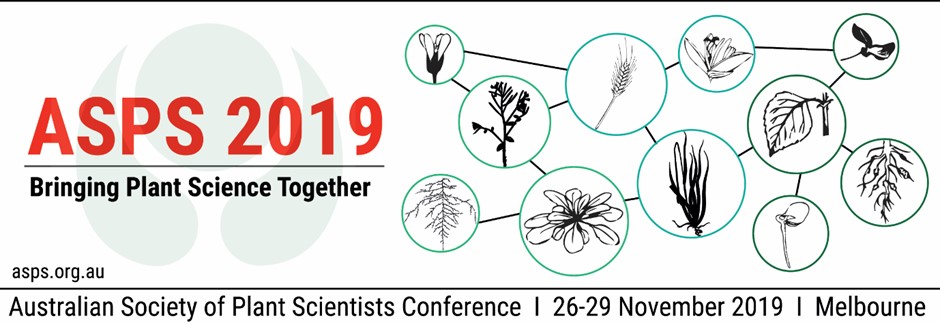

Extension to ASPS2019 registration and abstract submission.
02 July 2019
Hello ASPS members,
The deadline for ASPS2019 early bird registration and abstract submission has been extended to July 31st.
You can register for ASPS2019 here.
You can submit an abstract here.
ASPS2019 registration, abstract submission and ASPS student travel grant deadline in 1 week.,
24 June 2019
Hello ASPS members,
The deadline for ASPS2019 early bird registration, abstract submission and student travel grant applications are the end of this week.
You can register for ASPS2019 here.
You can submit an abstract here.
If you are a student or supervisor of a student who has been meaning to apply there is still time. Application here.
Extension to ASPS student travel grants, Phytogen and GPC E-Bulletin June editions
16 June 2019
Hello ASPS members,
The deadline for 2019 ASPS student travel grant applications has been extended to 5.00pm June 28th 2019. If you are a student or supervisor of a student who has been meaning to apply there is still time. Application attached.
You can also download the June edition of Phytogen here.
The Global Plant Council June E-Bulletin is available here.
Recent Posts
Tags
Archives
- June 2025
- May 2025
- April 2025
- March 2025
- February 2025
- January 2025
- December 2024
- November 2024
- October 2024
- September 2024
- August 2024
- July 2024
- June 2024
- May 2024
- April 2024
- February 2024
- January 2024
- November 2023
- October 2023
- September 2023
- August 2023
- July 2023
- June 2023
- May 2023
- April 2023
- March 2023
- February 2023
- December 2022
- November 2022
- October 2022
- September 2022
- August 2022
- July 2022
- June 2022
- May 2022
- April 2022
- March 2022
- February 2022
- January 2022
- December 2021
- November 2021
- October 2021
- September 2021
- August 2021
- July 2021
- June 2021
- April 2021
- March 2021
- February 2021
- January 2021
- December 2020
- November 2020
- October 2020
- September 2020
- August 2020
- July 2020
- June 2020
- May 2020
- April 2020
- March 2020
- February 2020
- January 2020
- December 2019
- November 2019
- October 2019
- September 2019
- August 2019
- July 2019
- June 2019
- May 2019
- April 2019
- March 2019
- February 2019
- January 2019
- December 2018
- November 2018
- October 2018
- September 2018
- August 2018
- July 2018
- June 2018
- May 2018
- April 2018
- March 2018
- February 2018
- January 2018
- December 2017
- November 2017
- October 2017
- September 2017
- August 2017
- July 2017
- June 2017
- May 2017
- April 2017
- March 2017
- February 2017
- January 2017
- December 2016
- November 2016
- October 2016
- September 2016
- August 2016
- July 2016
- June 2016
- May 2016
- April 2016
- March 2016
- February 2016
- January 2016
- December 2015
- November 2015
- October 2015
- September 2015
- August 2015
- July 2015
- June 2015
- May 2015
- April 2015
- March 2015
- February 2015
- January 2015
- December 2014
- November 2014
- October 2014
- September 2014
- August 2014
- July 2014
- June 2014
Copyright 2017 Australian Society of Plant Scientists Disclaimer & Privacy
Website by Michael Major Media



